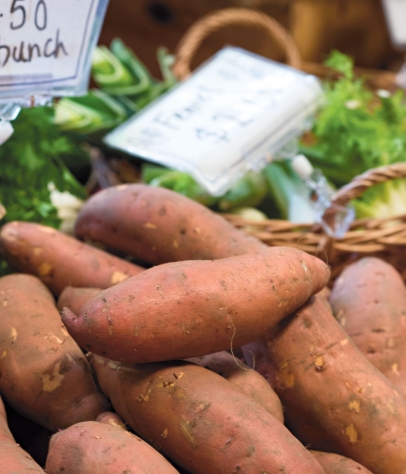Cooking Fresh: Michigan Sweet Potatoes
Sweet potatoes, those solid, tapered roots in shades of copper and red, evoke a sense of southern heritage, alongside pecan pie and sweet ice tea, for good reason—the top-producing states include North Carolina, Mississippi and Louisiana. This heat-loving crop does not have much history in Michigan, but in recent years intrepid farmers and home gardeners alike have given it a try. Lucky thing for avid cooks and eaters! Over the last few years sweet potatoes have become almost readily available at the local markets and it’s time we add them to our locavore lists to brighten our holiday meals and warm the colder days of winter.
Here are a few interesting facts about sweet potatoes, Ipomea batatas, which are native to North America. They belong to the morning glory family, a tropical vine. They are not a tuber, as potatoes are, but a true root. They are planted from “slips”—small plantlets started from root cuttings. They need warm or hot soil to grow and produce, and shouldn’t be planted until soil temps are at least 65. For this reason growers in northern climes often use black plastic mulch over the beds. They need a long growing season—usually June through end of September—but must be harvested before frost touches the leaves, otherwise they develop off-flavors and may not store well. Freshly dug sweet potatoes will develop more sweetness for about a month. And they don’t like refrigeration below 45°—ideal storage is at 60° with high humidity.
Sweet potatoes are one of the most nutrient-dense foods available. They are rich in beta-carotene, which the human body converts to vitamin A, and are a good source of vitamin C, fiber and potassium. They have a low glycemic index, which makes them a good source of nutrients for diabetics.
Sweet potatoes are not eaten raw and can be steamed, boiled, baked or roasted. In my experience, steaming and boiling tend to dilute their flavor and sweetness, while oven cooking methods intensify both. The white-fleshed varieties are dry and firm when cooked, akin to a russet potato, while the colorful varieties are moister and softer. Some varieties tend toward stringiness so it’s a good practice to cut them across rather than lengthwise. The skins are edible and often innocuous but just like with many such foods, their desirability is up to the eater or the cook, not the nutritionist.
Worth noting: In American stores, the term “yam” is used for the moister types of sweet potatoes—a marketing distinction originating in North Carolina which grew to dominate the varietal names. They are all sweet potatoes! A true yam is an unrelated root vegetable that originated in Africa.
Sweet Potato Cornmeal Waffles with Eggs and Ham
By Scotty Irani, Edible Oklahoma City
I went to our Edible friends in Oklahoma for this sweet potato brunch recipe. Perfect for the morning after a big holiday meal or an easy, quiet supper, anytime.
2 cups leftover (or fresh) mashed sweet potatoes
2 large eggs
1 cup all purpose flour
½ cup yellow corn meal
2 teaspoons baking soda
1 teaspoon salt
2 tablespoons melted butter
1 cup buttermilk
For topping:
leftover holiday ham
fresh arugula
poached eggs
Preheat your waffle iron according to manufacturer's directions. Put mashed sweet potatoes in a mixing bowl and mix in eggs one at a time. In a separate bowl combine flour, cornmeal, baking soda and salt; mix thoroughly. Add half the dry mixture to the sweet potato mixture and mix with a spoon. Add melted butter and half of the buttermilk. Mix again thoroughly. Repeat with remaining dry ingredients, then buttermilk. Mix into a batter. If the batter is too loose, add additional flour until you have a nice thick batter. Drop ¼–½ cup of the batter onto your hot waffle iron and cook approximately 10 minutes or until golden brown. Top the waffles with pan-grilled leftover holiday ham and a small handful of fresh arugula, then top with a freshly poached egg or two.














